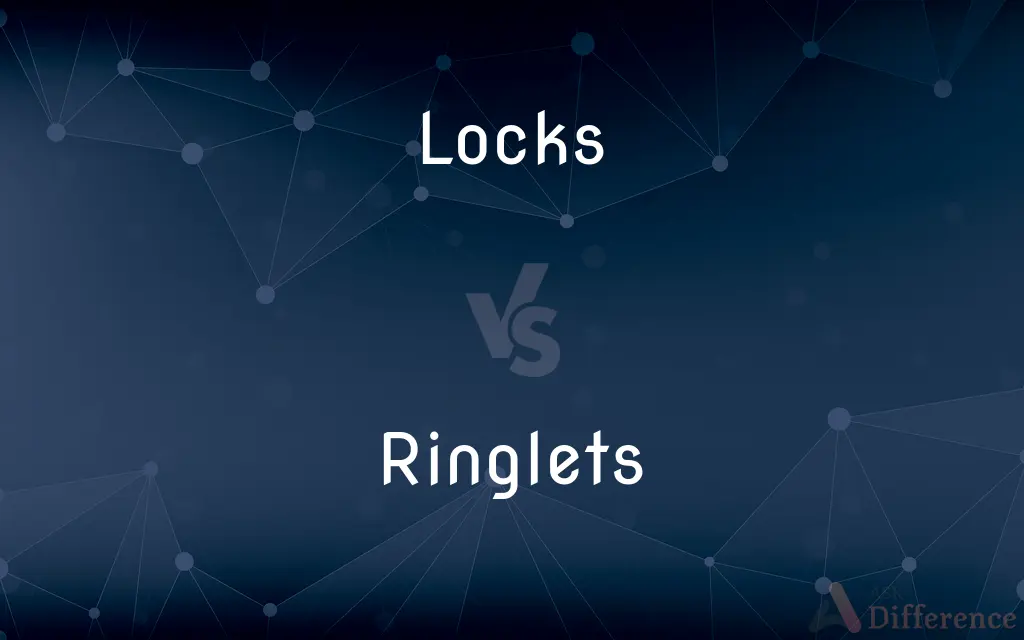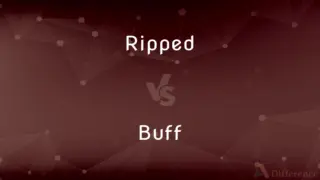Locks vs. Ringlets — What's the Difference?
By Tayyaba Rehman — Published on October 2, 2023
"Locks" refers to strands or tufts of hair, often long. "Ringlets" are specifically curls or coils of hair, typically forming spiral or circular shapes. Locks are general strands; ringlets are curled strands.

Difference Between Locks and Ringlets
Table of Contents
ADVERTISEMENT
Key Differences
Locks refer to strands or tufts of hair and do not prescribe any particular form or shape. They are often depicted as longer strands or portions of hair and can be used to describe hair on humans and animals. The term “locks” is quite general and broad, making it a versatile term for various hair types, whether straight, wavy, curly, or coiled. On the other hand, ringlets refer to a specific type of curl or coil in hair, often forming circular or spiral shapes. They are typically characterized by their tightly curled form, creating distinct, often springy curls that can be found in naturally curly hair or styled to achieve such curls.
While locks could imply any portion or strand of hair, regardless of its texture or form, they may also signify a specific hairstyle, such as dreadlocks, which are formed by matting or braiding hair. They do not inherently imply any curl or specific shape of the hair strands, allowing for broad applicability in various contexts related to hair. Conversely, ringlets are distinctly characterized by their curled form, implying a specific shape and texture of the hair strands. They represent a particular look and are usually associated with curly or wavy hair, either natural or styled, and may not apply to straight hair unless it is styled into curls.
In literature and artistic depiction, locks of hair are often used metaphorically or symbolically to represent beauty, strength, or individuality. They can be illustrated in various forms and styles, reflecting diversity in hair appearance and structure. The term “locks” allows for a wide range of interpretations and representations of hair, making it a versatile term in descriptive narratives and artistic expressions. In contrast, ringlets, with their specific curled form, are often associated with innocence, youth, and beauty, particularly in the depiction of children and women in art and literature. Their distinct shape makes them a precise term to describe hair with curled strands, offering a clear visual representation in descriptive contexts.
Understanding the difference between locks and ringlets is essential for accurate depiction and description of hair. Locks offer a general and versatile term to describe strands or tufts of hair, allowing for broad applicability in various contexts, without implying any specific form or texture of the hair. Ringlets, however, provide a specific and clear term to describe strands of hair curled in spiral or circular shapes, implying a distinct texture and appearance of the hair, suitable for contexts requiring precise description of curled hair strands.
Comparison Chart
Definition
Strands or tufts of hair.
Curls or coils of hair, forming spiral or circular shapes.
ADVERTISEMENT
Specificity
General term for strands of hair, regardless of form.
Specific term for curled strands of hair.
Texture and Form
Does not imply any particular texture or form.
Implies a specific curled form and texture.
Symbolism
Can represent beauty, strength, or individuality.
Often associated with innocence, youth, and beauty.
Applicability
Versatile, applies to various hair types and forms.
Precise, applies to hair with specific curled strands.
Compare with Definitions
Locks
It denotes tufts or clusters of hair.
He tied his locks into a neat ponytail.
Ringlets
Ringlets are curls or spirals of hair.
The child's golden ringlets bounced as she skipped along the path.
Locks
Locks refer to individual strands or sections of hair.
She brushed her long, golden locks before stepping out.
Ringlets
It denotes tightly coiled strands of hair.
She styled her hair in soft ringlets for the evening event.
Locks
Locks can signify long, flowing hair.
The princess was known for her radiant locks that reached her waist.
Ringlets
Ringlets signify hair curled in circular or spiral shapes.
The artist painted the young girl with ringlets falling over her shoulders.
Locks
A device operated by a key, combination, or keycard and used, as on a door, for holding, closing, or securing.
Ringlets
Ringlets can imply the youthful and innocent appearance of curled hair.
Her ringlets were a symbol of her playful and spirited personality.
Locks
A section of a waterway, such as a canal, closed off with gates, in which vessels in transit are raised or lowered by raising or lowering the water level of that section.
Ringlets
It represents curly or wavy hair in literature and art.
The character was described as having ringlets framing her delicate face.
Locks
A mechanism in a firearm for exploding the charge.
Ringlets
A long, spirally curled lock of hair.
Locks
An interlocking or entanglement of elements or parts.
Ringlets
A small circle or ring.
Locks
(Sports) A hold in wrestling or self-defense that is secured on a part of an opponent's body.
Ringlets
Plural of ringlet
Locks
A secure hold; control
The distributor has a lock on most of the market.
Locks
A sure thing; a certainty
His promotion is a lock.
Locks
A length or curl of hair; a tress.
Locks
Often locks The hair of the head.
Locks
A small wisp or tuft, as of wool or cotton.
Locks
To fasten the lock of
Close and lock a drawer.
Locks
To shut or make secure with or as if with locks
Locked the house.
Locks
To confine or exclude by or as if by means of a lock
Locked the dog in for the night.
Locked the criminal up in a cell.
Locks
To fix in place so that movement or escape is impossible; hold fast
The ship was locked in the ice through the winter. She felt that she had become locked into a binding agreement.
Locks
To sight and follow (a moving target) automatically
Locked the enemy fighter in the gun sights.
Locks
To aim (a weapon or other device) at a moving target so as to follow it automatically
"The pilot had locked his targeting radar on the slow-moving frigate" (Ed Magnuson).
Locks
To clasp or link firmly; intertwine or interlock
Locked arms and walked away.
Locks
To bind in close struggle or battle
The two dogs were locked in combat.
Locks
To equip (a waterway) with locks.
Locks
To pass (a vessel) through a lock.
Locks
To invest (funds) in such a way that they cannot easily be converted into cash.
Locks
To arrange or secure (an interest rate) for a loan.
Locks
To end the processing of (a magnetic tape or disk) in such a way as to deny access to its contents.
Locks
To protect (a file) from changes or deletion.
Locks
To become fastened by or as if by means of a lock
The door locks automatically when shut.
Locks
To become entangled or jammed; interlock.
Locks
To become rigid or immobile
The mechanism tends to lock in cold weather.
Locks
To pass through a lock or locks in a waterway.
Locks
Plural of lock
Locks
A head of hair; tresses.
Locks
(colloquial) Dreadlocks.
Locks
Locks can imply a hairstyle formed by matting or braiding hair.
His dreadlocks were a symbol of his personal style and beliefs.
Locks
It represents portions of hair in literary and artistic expressions.
Her locks flowed like a cascade of silken threads in the moonlight.
Common Curiosities
Are ringlets always naturally occurring in hair?
No, ringlets can be natural or styled.
Can locks be curly or straight?
Yes, locks can refer to any strands of hair, regardless of their texture.
Do locks always refer to long strands of hair?
No, locks refer to strands or tufts of hair, but they do not inherently specify the length.
Are ringlets typically tight curls?
Generally, yes, but the tightness of the curl can vary.
Do ringlets always represent innocence and youth?
While often associated with innocence and youth, ringlets can be a stylistic choice for anyone.
Can the term "locks" refer to a hairstyle?
Yes, "locks" can refer to specific hairstyles like dreadlocks.
Do locks always have to be well-defined strands?
No, the term "locks" is general and does not specify the definition or structure of the strands.
Can locks be used metaphorically?
Yes, locks can be used metaphorically to represent various attributes like beauty or strength.
Can straight hair be styled into ringlets?
Yes, straight hair can be styled into ringlets using curling tools.
Do ringlets require maintenance to retain their shape?
Yes, ringlets may require maintenance and care, especially if they are styled.
Can the term "locks" be used to describe animal hair?
Yes, "locks" can describe tufts or strands of animal hair.
Can ringlets occur in short hair?
Yes, as long as the hair is long enough to curl, it can form ringlets.
Share Your Discovery

Previous Comparison
Ripped vs. Buff
Next Comparison
Nail Polish vs. EnamelAuthor Spotlight
Written by
Tayyaba RehmanTayyaba Rehman is a distinguished writer, currently serving as a primary contributor to askdifference.com. As a researcher in semantics and etymology, Tayyaba's passion for the complexity of languages and their distinctions has found a perfect home on the platform. Tayyaba delves into the intricacies of language, distinguishing between commonly confused words and phrases, thereby providing clarity for readers worldwide.











































